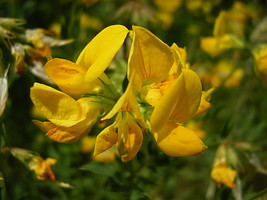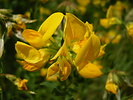Hologalegina
Martin F. Wojciechowski


This tree diagram shows the relationships between several groups of organisms.
The root of the current tree connects the organisms featured in this tree to their containing group and the rest of the Tree of Life. The basal branching point in the tree represents the ancestor of the other groups in the tree. This ancestor diversified over time into several descendent subgroups, which are represented as internal nodes and terminal taxa to the right.

You can click on the root to travel down the Tree of Life all the way to the root of all Life, and you can click on the names of descendent subgroups to travel up the Tree of Life all the way to individual species.
For more information on ToL tree formatting, please see Interpreting the Tree or Classification. To learn more about phylogenetic trees, please visit our Phylogenetic Biology pages.
close boxIntroduction
"Hologalegina" is an informal name given to the largest of the well-supported major clades of papilionoids (Wojciechowski et al., 2000). It contains the mainly Old World tribes Galegeae, Carmichaelieae, Cicereae, Hedysareae, Trifolieae, Fabeae (a.k.a. Vicieae) plus Loteae sens. lat. (Loteae and Coronilleae) and predominantly New World Robinieae. This clade includes over 4,800 species which make up the vast majority of predominantly herbaceous legumes distributed in temperate regions of the world (especially Eurasia, North and South America), including many of the familiar, domesticated crop and forage legumes such as Pisum sativum (garden pea), Medicago sativum (alfalfa), Lens (lentils), Cicer arietinum (chickpea), (Trifolium spp. (clovers), Vicia faba (faba bean), Wisteria spp. (wisterias), Astragalus (locoweeds; the largest genus of vascular plants, with 2,500 spp.), and the genetic/genomic model species Medicago truncatula (barrel medic), Pisum sativum (garden pea), and Lotus corniculatus. Unlike some of the other major papilionoid subclades, Hologalegina lacks an Early Eocene fossil record. Remarkably the mean age of this crown clade is estimated at 50.6 Ma (Lavin et al., 2005).
Discussion of Phylogenetic Relationships
Hologalegina corresponds closely to Polhill's (1981, 1994) "temperate herbaceous group", or the "galegoid alliance" as it is sometimes called, long considered a natural group based on a combination of morphological and anatomical features shared by most of its members and centers of diversity (and presumed origin) in Eurasia and to a lesser extent, North America. Two well-supported subclades, the "robinioids" and the "Inverted Repeat-lacking" clade or IRLC, comprise Hologalegina. Evidence for this clade emerged from early phylogenetic studies based on the rbcL gene (Doyle et al., 1997; Käss and Wink, 1997) but sampling was sparse and support was quite limited. The monophyly of Hologalegina is now substantiated by phylogenetic analyses of both plastid matK/trnK sequences (Hu et al., 2000; Wojciechowski et al., 2000, 2004), from nuclear PHY gene sequences (Lavin et al., 1998) and rDNA ITS sequences (Hu, 2000), and an early supertree analysis based on published molecular studies (Wojciechowski et al., 2000). These same studies have conclusively shown strong support not only for the two subclades, the IRLC and Robinioids, but also for a sister group relationship of Hologalegina to the Millettioids sens. lat. clade.
References
Doyle, J. J., J. L. Doyle, J. A. Ballenger, E. E. Dickson, T. Kajita and H. Ohashi. 1997. A phylogeny of the chloroplast gene rbcL in the Leguminosae: taxonomic correlations and insights into the evolution of nodulation. American J. Botany 84: 541–554.
Hu, J.-M. 2000. Phylogenetic relationships of the tribe Millettieae and allies-the current status. Pages 299-310 in Advances in Legume Systematics, part 9 (P. S. Herendeen and A. Bruneau, eds.). Royal Botanic Gardens, Kew, UK.
Hu, J.-M., M. Lavin, M. F. Wojciechowski, and M.J. Sanderson. 2000. Phylogenetic systematics of the tribe Millettieae (Leguminosae) based on matK sequences, and implications for evolutionary patterns in Papilionoideae. American J. Botany 87: 418-430.
Käss, E., and M. Wink. 1997. Phylogenetic relationships in the Papilionoideae (Family Leguminosae) based on nucleotide sequences of cpDNA (rbcL) and ncDNA (ITS1 and 2). Molecular Phylogenetics and Evolution 8:65-88.
Lavin, M., J. J. Doyle, and J. D. Palmer. 1990. Evolutionary significance of the loss of the chloroplast--DNA inverted repeat in the Leguminosae subfamily Papilionoideae. Evolution 44: 390-402.
Lavin, M., E. Eshbaugh, J.-M. Hu, S. Mathews, and R. A. Sharrock. 1998. Monophyletic subgroups of the tribe Millettieae (Leguminosae) as revealed by phytochrome nucleotide sequence data. American J. Botany 85: 412-433.
Lavin, M., P. S. Herendeen, and M. F. Wojciechowski. 2005. Evolutionary rates analysis of Leguminosae implicates a rapid diversification of lineages during the Tertiary. Systematic Biology 54: 530-549.
Polhill, R. M. 1981. Papilionoideae. Pages 191-208 in Advances in Legume Systematics, part 1 (R. M. Polhill and P. Raven, eds.). Royal Botanic Gardens, Kew, UK.
Polhill, R. M. 1994. Classification of the Leguminosae. Pages xxxv-xlviii in Phytochemical Dictionary of the Leguminosae (F.A. Bisby, J. Buckingham, and J.B. Harborne, eds.). Chapman and Hall, New York, NY.
Wojciechowski, M. F., M. Lavin, and M. J. Sanderson. 2004. A phylogeny of legumes (Leguminosae) based on analysis of the plastid matK gene resolves many well-supported subclades within the family. American J. Botany 91: 1846-1862.
Wojciechowski, M. F., M. J. Sanderson, K. P. Steele, and A. Liston. 2000. Molecular phylogeny of the “temperate herbaceous tribes” of papilionoid legumes: a supertree approach. Pages 277-298 in Advances in Legume Systematics, part 9 (P. S. Herendeen and A. Bruneau, eds.). Royal Botanic Gardens, Kew, UK.
Title Illustrations

| Scientific Name | Pisum sativum L. |
|---|---|
| Specimen Condition | Live Specimen |
| Body Part | fruit |
| Copyright | © H. Schneider |
| Scientific Name | Robinia neomexicana A. Gray |
|---|---|
| Location | Mount Ord, AZ |
| Copyright |
© Martin F. Wojciechowski

|
| Scientific Name | Lotus corniculatus L. |
|---|---|
| Copyright | © Franco Tobias |
About This Page
Martin F. Wojciechowski

Arizona State University, Tempe, Arizona, USA
Correspondence regarding this page should be directed to Martin F. Wojciechowski at
Page copyright © 2006 Martin F. Wojciechowski
All Rights Reserved.
- First online 14 June 2006
- Content changed 14 June 2006
Citing this page:
Wojciechowski, Martin F. 2006. Hologalegina. Version 14 June 2006 (under construction). http://tolweb.org/Hologalegina/60342/2006.06.14 in The Tree of Life Web Project, http://tolweb.org/











 Go to quick links
Go to quick search
Go to navigation for this section of the ToL site
Go to detailed links for the ToL site
Go to quick links
Go to quick search
Go to navigation for this section of the ToL site
Go to detailed links for the ToL site